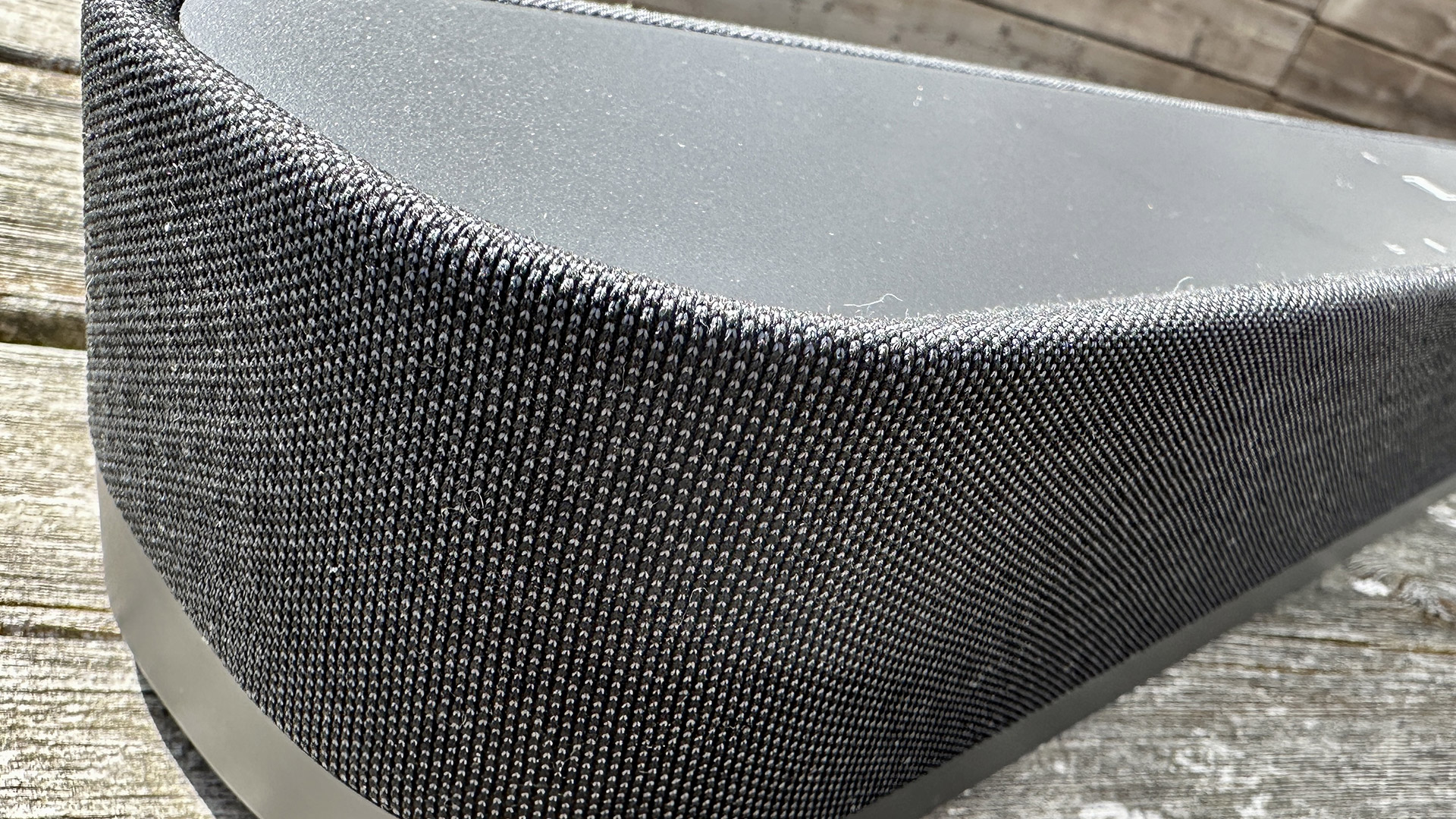
Sennheiser Ambeo Mini review: Two-minute review
The Sennheiser Ambeo Mini arrives as the smallest, most affordable member of what is now a three-strong family of Sennheiser Ambeo soundbars. What it lacks in stature, though, it makes up for in asking price. Compared to the best soundbars, this is not a budget-conscious option, especially when you consider how much the best of its size-comparable rivals cost.
The Ambeo Mini goes a long way to justifying its asking price even before it’s plugged in, though. Its six-driver speaker array is powered by 250 watts and has the grunt to reach down to a claimed 43Hz at the bottom of the frequency range. It is subject to some very thorough virtualisation technology in an effort to extract a true sense of spatial audio from a soundbar with no dedicated ‘top’ effects drivers. And it’s concealed inside a discreet, well-made cabinet that’s never going to draw attention to itself.
There’s also the choice of control options. Between the ‘Smart Control’ app, the full-size remote control handset, built-in Amazon Alexa voice-control and some integrated touch-controls, you’re not short of options here – and they’re all beautifully realised and eminently usable.
Performance, though, is where a product like this lives or dies – and in almost every respect, the Sennheiser Ambeo Mini is alive and kicking. Literally kicking where bass response is concerned, the amount of drive and punch it can summon is remarkable given the discreet proportions of its cabinet. It creates a big, open soundstage, piles on the details at every point, and is able to project dialogue to the front without it ever sounding remote or estranged. It’s even pretty adept at generating an impression of spatial audio from 5.1 or even two-channel movie content, although trying to pretend a stereo music file consists of 12 channels proves a bridge too far.
Only the rather modest sensation of true audio ‘height’ to its sound prevents the Sennheiser Ambeo Mini waltzing off with full marks. Or, rather, it’s the combination of this slight reticence along with pricing that suggests expertise in every area that holds it back just a little. If it sounded just a little taller, or if it were just a little less expensive, the Ambeo Mini would be approaching ‘no-brainer’ status.
Sennheiser Ambeo Mini review: Price and release date

- On sale September 1 2023
- $799 / £699 / AU$1299
The Sennheiser Ambeo Mini is on sale across the world from September 1 2023. In the United Kingdom it sells for £699, while in the United States the going rate is $799. Customers in Australia will need to part with AU$1299 to acquire one.
Yes, this is the most affordable of Sennheiser’s three-strong ‘Ambeo’ range of soundbars – but that’s not the same thing as ‘affordable’, not really. This pricing puts the Ambeo Mini into competition with the well-regarded likes of Samsung’s HW-Q930B and the Arc by Sonos, both of which seem to offer plenty more – not least where dimensions are concerned.
Sennheiser Ambeo Mini review: Features

- 250 watts of Class D power
- 43Hz - 20kHz frequency response
- 7.1.4 -channel virtualised sound
It’s not, strictly speaking, a feature but more of an ambition: the Sennheiser Ambeo Mini intends to create an impression of 7.1.4 -channel spatial audio using just six speaker drivers and a whole lot of complicated virtualisation technology developed in conjunction with Fraunhofer. And that means every worthwhile spatial audio standard out there, too. The Ambeo Mini is compatible with Dolby Atmos, DTS:X, MPEG-H and 360 Reality Audio, putting it on par with the best Dolby Atmos soundbars.
Two of the six drivers are upward-facing 102mm (4in) bass drivers that offer low-frequency extension down to a claimed 43Hz. The other four are 38mm (1.5in) full-range numbers. There is one at either end of the chassis, positioned to create some sonic width, and two more fire forwards. All six drivers are made of cellulose, and all six contribute to the virtualised ‘top’ effects that ought to allow the Ambeo Mini to create a sensation of height to its presentation.
Class D amplification supplies the power, and there’s a total of 250 watts on tap. Sennheiser isn’t saying exactly how it’s divvied up - but then again, brands like Sonos don’t even like to say how much power is on board its soundbars, so I guess we should be grateful for any information that Sennheiser supplies…
As far as connectivity is concerned, the Ambeo Mini has ample wireless options and just the essentials as far as physical connections go. An HDMI eARC and a USB-A slot sit alongside a mains power socket, a ‘reset’ button and a ‘setup’ button in a recess on the rear of the chassis - and that’s your lot in terms of the physical stuff. The lack of HDMI passthrough may conceivably be a deal-breaker for some customers, especially as quite a few similarly priced alternatives include it.
Wi-Fi and Bluetooth 5.0 (with SBC and AAC codec compatibility) cover off the bulk of the wireless stuff, and there is compatibility with UPnP, the ‘Connect’ versions of Spotify and Tidal, with Apple AirPlay 2 and with Google Chromecast. The last couple mean that the Ambo Mini can easily become part of a multi-room audio system.
Features score: 4.5/5
Sennheiser Ambeo Mini review: Sound quality

- Remarkable low-frequency presence and control
- Sound is far bigger than the product’s physical dimensions
- Not the most spatial of spatial audio presentations
The Ambeo Mini wastes no time in calibrating itself to your specific environment, and once it’s done so there are numerous positives about the way it goes about churning out the sound of movies and music alike.
It goes without saying that the best results come from the best sources – and when given the Dolby Atmos soundtrack to a UHD 4K Blu-ray disc of Dune to deal with, you’ll quite quickly forget the ‘mini’ aspect of the Ambeo Mini and concentrate on the mightiness of its presentation.
Most immediately, its low-frequency punch and presence is almost startling. 43Hz is deep, sure - but the bass the Sennheiser generates is so solid, so controlled and so full of variation that it sounds even deeper, somehow. Sennheiser is pleased with the fact that you can connect as many as four wireless Ambeo subwoofers to the Mini, but unless you are setting up your soundbar in a big, vaulted space I’d seriously question whether you need even one.
Midrange fidelity is impressive – the centre channel of audio information is always the most critical, and the Ambeo Mini delivers it with authority, packing voices with detail and character. It projects well, even when the low end is strutting its stuff, and is able to retain plenty of information about tone and texture even when the soundtrack is at its most bullish. And despite the lack of dedicated tweeters here, the Sennheiser has ample bite and brilliance at the top of the frequency range, along with the requisite levels of detail.
The whole of the frequency range hands together well and, although the Ambeo Mini is undoubtedly working its socks off to create what it reckons is a facsimile of 12 channels of information using just six drivers, there’s a coherence to the way it delivers the Dolby Atmos soundtrack. The soundstage it creates is way bigger than the soundbar from which it emanates, and long-travel effects move around the stage in pretty convincing fashion.
What there isn’t a huge amount of, though, is sonic height to the sound. Yes, the Sennheiser can put sound upwards with reasonable success - but even when accompanying a 48in OLED TV (for which the Ambeo Mini is the perfect size to fit between its feet), sound never really gets above the television’s top bezel. This slight lack of upward projection will be familiar to anyone who’s heard the (similarly sized, much more affordable) Sonos Beam Gen 2.
In every other respect, though, the Ambeo Mini has the better of the size-comparable Sonos. It’s more dynamic, able to make you jump when the ‘hissed exposition’ switches suddenly to ‘almighty action sequence’. It’s more open, able to create greater width across the front of the soundstage and position effects more precisely. And it’s more punchy, too. Quite a lot more punchy.
With a feed of Match of the Day 2 coming in via the BBC iPlayer, Sennheiser’s ‘Ambeo’ virtualisation technology does impressive work in hacking even a mild sensation of spatial audio from the stereo source. The stage is still big, detail levels are still high, and the ‘smack’ as boot addresses ball is profound. Switch off the ‘Ambeo’ processing and the sensation of scale pretty much disappears - although this is still a fuller and more enjoyable sound than most TVs have a hope of delivering by themselves.
Using Tidal Connect to stream a Dolby Atmos file of You Ain’t No Celebrity by Jungle featuring Roots Manuva lets the Ambeo Mini once again demonstrate its powers of resolution, of even-handed frequency response, of prodigious low-end presence and control, and of simple scale. The sound is open and well-separated, but unified and focused at the same time - and the virtualisation technology does good work in summoning up authentic width and a degree of height to the sound. Use Bluetooth to stream a two-channel file of Grouper’s Alien Observer and the ‘Ambeo’ technology can’t prevent a little vagueness creeping into the presentation as it attempts to open the recording up and out as much as possible. Ultimately, it’s better - or, more accurately, more convincing - to leave stereo music unvirtualised. You miss out on sheer size, but the sound has greater accuracy.
Sound quality score: 4.5/5
Sennheiser Ambeo Mini review: Design

- 65 x 700 x 100mm / 2.6 x 27.6 x 3.9in (HxWxD)
- 3.3kg
- Almost entirely plastic and acoustic cloth construction
If you’re even remotely familiar with Sennheiser’s recent Ambeo Plus soundbar and the Sonos Beam Gen 2, you already have a good idea of what the Ambeo Mini is like in terms of design.
In its cloth-wrapped plastic construction and its slanted top panel, the Ambeo Mini looks just like - hey! - a miniature version of the Ambeo Plus. And its dimensions are almost exactly the same as that of the Sonos Gen 2 – so it competes in aesthetic terms if not where price is concerned.
As you might imagine, the quality of build and finish here is basically impeccable. Everything is put together flawlessly, and the Ambeo Mini is made from materials that are durable and even quite tactile. There’s nothing luxurious about the Ambeo Mini, and it’s hard to make a product as functional as a soundbar stand out in design terms…
Nevertheless, there’s something quite appealing about its combination of discretion and purposefulness. Some may hanker after a choice of finish, of course – but Sennheiser has long been of the opinion that Henry ‘any colour you like as long as it’s black’ Ford was on to something…
Design score: 4.5/5
Sennheiser Ambeo Mini review: Setup and usability

- Automatic room calibration
- Voice, app and remote control
- Numerous listening modes
We have to give credit where credit is due: Sennheiser has made setting up the Ambeo Mini about as straightforward and painless as is realistically possible.
Put the soundbar in position. Make your two connections – the figure-of-eight socket to the mains and the HDMI eARC socket to the corresponding connection on your TV – and you’re all set. Then it’s simply a question of opening the ‘Smart Control’ app and letting the automatic room calibration routine do its thing. A fairly brief selection of test tones plays while the app assures you that all is well, and then the Ambeo Mini is optimised for the position in which it finds itself. And it’s easy to recalibrate should the need arise.
Once the Ambeo Mini is set up, controlling it is equally straightforward no matter which of the numerous interaction options you prefer. The control app itself is typically Sennheiser inasmuch as it’s flawlessly realised, clear and logical, and covers every realistic eventuality. As well as the ability to switch the ‘Ambeo’ virtualisation technology on or off, there are six EQ settings (from ‘adaptive’ to ‘neutral’ via ‘music’ and ‘movie’), a ‘night mode’ that squashes dynamic response and ‘voice enhancement’ that pushes the centre channel information forwards. Input selection, software updates and all the rest are available here too.
There’s a brief selection of capacitive touch-controls on the slanted top of the soundbar which cover most major functions - and there’s a ‘mute’ button to disable the four inbuilt mics. As well as calibration, these mics handle voice control - so if you want to use your Ambeo Mini simply by talking to it, Amazon Alexa is built in and Google Assistant is also available if you’ve appropriate speakers on a common network.
Or you may prefer the old-school charms of a remote control handset. The wand supplied with the Ambeo Mini is tactile and angular, and covers more-or-less everything in terms of day-to-day control of the soundbar. Its labels could be larger, sure, and some backlighting wouldn’t go amiss… but it’s fair to say that some more expensive soundbars are supplied with much less satisfactory remote controls.
Setup and ssability score: 5/5
Sennheiser Ambeo Mini review: Value

- Big, authoritative sound with no need for a subwoofer
- Exemplary build and finish, great control options
- Cannot help but seem just a little too expensive
Ultimately, the Sennheiser Ambeo Mini seems just a little expensive. A small part of that is down to the sheer size of the product - because for all that it is beautifully built and finished from materials that seem durable, and has several well-realised control options, perceived wisdom is that soundbars this small don’t cost this much money and soundbars costing this much money are bigger than this.
Of course, there’s nothing wrong with paying a premium price for a more manageably sized soundbar if you don’t have that big a room to fill with sound - but only if it can outperform more affordable alternatives in every department. As it is, though, the Sennheiser Ambeo Mini can only outperform its more affordable alternatives in most departments - in what is arguably the most important of the lot, the truly ‘spatial’ aspect of ‘spatial audio’, it comes up just fractionally short.
Value score: 4.5/5
Should you buy the Sennheiser Ambeo Mini?
Buy it if...
Don't buy it if...
Sennheiser Ambeo Mini: Also consider

How I tested the Sennheiser Ambeo Mini

The Sennheiser Ambeo Mini has been positioned between the feet of a 48in Philips OLED TV for the best part of a fortnight now, and it’s been used for at least a few hours every day - some of that is critical listening, some is simply sitting down in front of the telly to unwind of an evening.
The room is open-plan, which means side boundaries are fairly distant, but the ceiling is not especially high - so the fact the Ambeo Mini can create plenty of sonic width is particularly commendable, while the relative lack of sonic height isn’t.
Content of all kinds has been through the Sennheiser, from native Dolby Atmos stuff via a UHD 4K Blu-ray player, Netflix and Disney+, and TIDAL Connect, to the bog-standard two-channel content available via broadcast TV or catch-up services.
First reviewed August 2023







